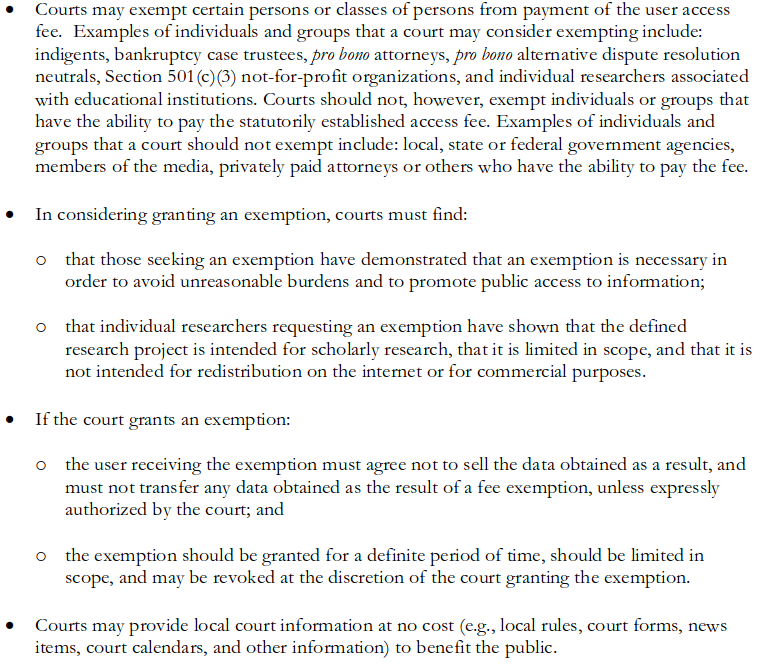Facts About PACER and CM/ECF

PACER and CM/ECF together form a big and complex system with decades of history that's difficult to research or understand. For several years we have been trying to learn as much about these systems as we can.
This page is an attempt to keep a record of interesting facts we have gathered about these systems. Where possible, we link to backup copies of various resources or provide links to the original sources.
If you identify errors or omissions, please get in touch.
How much money does PACER bring in each year?
A lot. In 2015 PACER brought in about $145M. We have a detailed post about this, and you can look up this information using links like:
http://www.gpo.gov/fdsys/pkg/BUDGET-1998-APP/pdf/BUDGET-1998-APP-1-4.pdf
Simply replace 1998 with the desired year. In the PDF that you download, PACER revenue is listed under #0220 of the Judiciary Information Technology Fund.
How much would it cost to download all of PACER?
We tried to get to the bottom of this. Our conclusion was that it would cost around one billion dollars.
Are there any ways to get around PACER fees?
There are a few ways to avoid PACER fees, as described in the PACER fee schedule:
-
Some documents are labeled by clerks as "Opinions" and are free. In theory — and according to the E-Government Act — this would include all of the opinions issued, but in our research this has varied greatly by jurisdiction. These documents can be found by using the "Written Opinions" report.
-
All PACER users are allowed $30 per calendar quarter before they are billed. However, once you hit $30.01 on your bill, you will be billed the entire amount.
-
If you are a part of case, you're granted "One free look" at each document filed in that case. These expire after 15 days.
-
No fee is charged if PACER is used at a courthouse public access terminal.
-
PACER provides fee exemptions (or waivers) according to the following rules:

These rules call for numerous limitations such as non-redistribution, and limited periods of time. There is at least one instance, however, where a judge has not applied all of these rules, and has allowed redistribution.
Additional examples of PACER fee waivers can be found in the RECAP Archive.
What if I'm a government employee, say at the DOJ — Surely I don't pay PACER fees, right?
This is a reasonable thought but even the DOJ must pay PACER fees. In fact, according to a FOIA request in 2015, and another more recently, the DOJ has made the following annual PACER payments:
| Year | Amount |
|---|---|
| 2010 | $1,554,641.92 |
| 2011 | $1,742,514.76 |
| 2012 | $1,918,149.77 |
| 2013 | $4,596,026.64 |
| 2014 | $4,317,820.96 |
| 2015 | $3,152,377.52 |
| 2016 | $3,341,286.56 |
| 2017 | $3,862,912.86 |
| 2018 | $4,869,444.80 |
| 2019 | $5,042,601.30 |
| 2020 | $4,963,957.50 |
| 2021 | $5,490,794.30 |
| 2022 | $5,368,888.90 |
| 2023 | $5,634,474.10 |
| Total | $55,855,891.89 |
Thank you to Jonathan Rudenberg and Fix the Court for filing FOIA requests and sharing the results.
How many cases and documents are in PACER and how fast is it growing?
We have two sources for this information. One source is the 2014 Annual Supreme Court Report, which said:
CM/ECF currently contains, in aggregate, more than one billion retrievable documents spread among the 13 courts of appeals, 94 district courts, 90 bankruptcy courts, and other specialized tribunals.
The second source is an article (webpage/pdf) in the International Journal for Court Administration, entitled, "E-Filing Case Management Services in the US Federal Courts: The Next Generation: A Case Study". That article says:
Presently, CM/ECF databases contain over 47,000,000 cases and well over 600,000,000 legal documents; approximately 2,000,000 new cases and tens of millions of new documents are entered each year
Written opinions are free on PACER, but how are they defined?
After downloading all of the written opinions, we completed a brief analysis (xlsx) and discovered that courts are wildly inconsistent about marking documents as opinions. For example, in our analysis we discovered that the busiest court in the country, NY Southern District (NYSD), has about 10% as many written opinions as California's Central District, and that NYSD comes in 21st place across the country when it should be first in terms of output.

This disparity likely stems from clerks and judges improperly (or inconsistently) marking documents as opinions. The official policy explaining when to mark a document as an opinion is from a 2004 memo to the chief justices.1 In short, a written opinion is defined as:
any document issued by a judge or judges of the court, sitting in that capacity, that sets forth a reasoned explanation for a court's decision.
Five additional clarifying points also apply which can be read in the memo.
Many documents are not marked as opinions that should be. We know of no recourse if you purchase such a document, though a lawsuit is working to fix that, and the issue is being studied by academics.
What do we know about PACER users?
-
According to an a declaration by the PACER Service Center manager, 63% of PACER users did not pay fees in 2015.
-
75% of revenue comes from 1% of users, according to Robert Lowney, director of the PACER program. The implication here is that those 1% of users are likely bots.
Who runs PACER and the CM/ECF help desk?
PACER is officially run by the Administrative Office of the US Courts, but it's unclear how much of the actual work they do. It does seem like there is some number of admins within each jurisdiction handling upgrades and day-to-day server maintenance. From what we've gathered, the number of these people varies by the busyness of the court. In jurisdictions with slow courts (think: North Dakota, say), there can be just one person running both the bankruptcy and the district court. In others, it seems like they've got more robust staffing.
Outside of the day-to-day tasks and maintenance, much of the work seems to be outsourced to Camber Corporation. In 2016, Camber Corporation was purchased by Huntington Ingalls Industries, the largest military shipbuilder in the United States.
Here's what we've been able to find about Camber Corp:
-
This is their hiring page: https://hii-mdis.jobs/jobs/?q=pacer. Some titles we've seen pop up are Customer Service Analyst, System Administrator, and Security System Administrator.
-
In 2013, they were involved in a Fair Labor Standards Act lawsuit in W.D. Texas. This lawsuit indicates that one of their activities was arms manufacturing.
-
We've been unable to find their contract with the AO, but we did find the bid solicitation for their contract with the AO.
Has there ever been an effort to transfer PACER records to the National Archives?
It seems so, but to our knowledge nothing has ever been transferred. More investigation is likely needed on this topic.
Are there PACER/ECF sites where I can poke around, experiment, and try things?
Yes! There are several PACER sites that we know about that have content and do not charge for usage:
- The official PACER training website
- A training website maintained by the Court of International Trade
- A training website maintained by the Bankruptcy Court of the Northern District of Georgia
- For appellate, the Court of Appeals for Veterans Claims runs a free site
The CIT training site also allows you to practice ECF filings if you have an ECF account.
Is PACER used anywhere other than the federal courts?
Yes! Mississippi is using PACER for e-filing in their courts.
Does PACER Have an API?
Contrary to popular wisdom, PACER does have something resembling an API for some purposes:
-
There is an API, sort of, for the PACER Case Locator (PCL), that allows limited search of PACER metadata across jurisdictions. It only allows you to look up cases, and it is delayed by about a day (we believe it takes this long for the central search system to get the updates of the day).
We've asked the AO to publish this documentation, but they either can't or won't, so we host it for them. Here's the old version, and the new. We post both of these because the old documentation has some information that was removed from the new. We informed the AO of this, but they've opted not to make documentation that is both complete and up to date.
This API has been declared "Legacy," and there are promises of a new system someday. At that point, we'll presumably host that documentation as well.
-
There is also information about the XML formats returned by PACER.
-
For uploads, there is only information for uploading bankruptcy files.
-
There is also documentation from 2005 about "bulk data" files here (PACER does not actually have bulk data).
-
The FJC manages an "Integrated Database" which has extensive documentation about PACER fields and data. We have our own cheat sheet for the IDB as well.
-
Finally, we have created an open source system for crawling PACER.
As a developer, is there a way to stay up to date with PACER?
Yes! There is a list for developers to subscribe to at developers@psc.uscourts.gov. You can sign up here.
Start and End Dates for Jurisdictions
There's a variety of information that you can find on the list of courts on the PACER site, if you click the little information icon . We've taken some of this information and built a simple JSON or HTML website with it, so it's all in one place.
Included in that information is the "Go Live Date" for each jurisdiction, but some jurisdictions have cases going back much further. Our understanding is that the older cases in PACER were put in manually, so the quality of the data is poor and the coverage is incomplete. However, you can get a list of all the earliest cases at this link or as a spreadsheet.
Footnotes
-
We are grateful to Rebecca Fordon and Stephen Burbank for their assistance in this research. ↩
